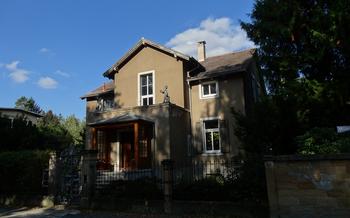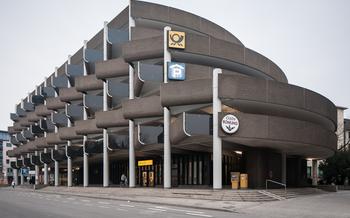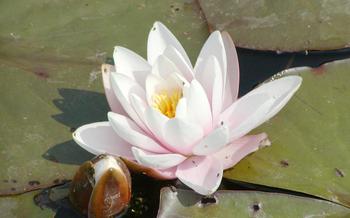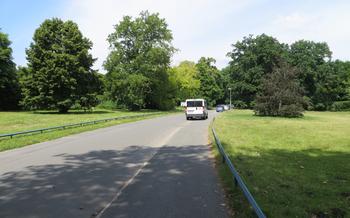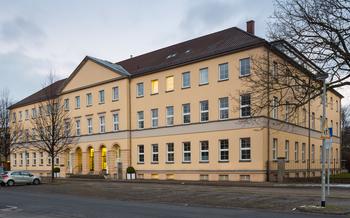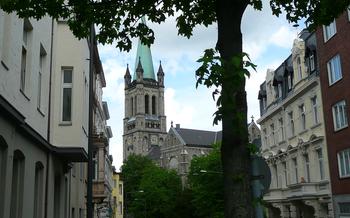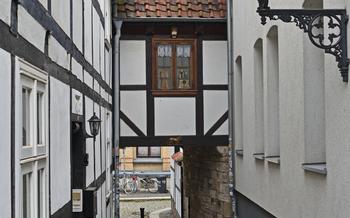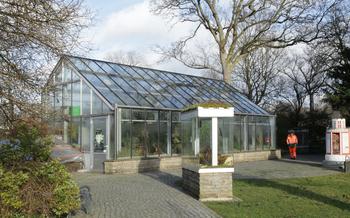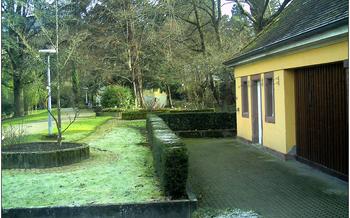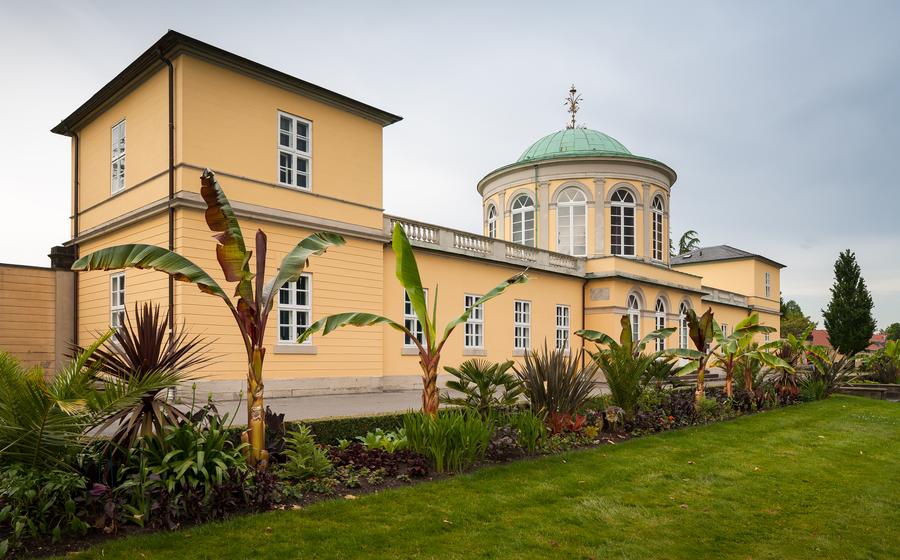
Berggarten
- Hanover Berggarten
- Park Features
- Thematic Gardens
- Sculpture Collection
- Herbs, Spices, and Medicinal Plants
- Garden Highlights
- Events and Exhibitions
- Guided Tours
- Accessibility
- Visitor information
- Food and Drinks
- Tips for Visitors
- Things to Do Nearby
- Insider Tip: Hidden Gems Within the Garden
Hanover Berggarten
A hidden gem nestled in the heart of Hanover, the Berggarten is a botanical garden that offers a delightful retreat from the city's hustle and bustle. Its history dates back to 1666 when it was founded as a physic garden by Johann Friedrich, Duke of Brunswick-Lüneburg. Initially used for cultivating medicinal plants, the garden evolved into a center for botanical research and education. Today, it encompasses 20 hectares of diverse gardens, greenhouses, and a remarkable collection of sculptures, inviting visitors to explore the wonders of the plant kingdom.
Geographical Location and How to Get There:
The Berggarten is conveniently situated in the Herrenhausen district, just a short walk from the Herrenhausen Gardens. To get there, take the U-Bahn line 1 or 2 to the Herrenhäuser Gärten stop. From there, it's a pleasant five-minute stroll through the Georgengarten to reach the Berggarten entrance.
Current Use of the Garden:
The Berggarten serves multiple purposes. It's a popular destination for locals and tourists seeking respite and relaxation amidst nature. It's also a valuable resource for botanists and researchers, housing a significant collection of plant species for study and conservation. Additionally, the garden hosts various events and exhibitions throughout the year, making it a vibrant cultural hub.
Park Features
The Berggarten offers a diverse range of gardens and greenhouses, showcasing a wide variety of plant life from around the world.
-
Gardens and Greenhouses: The park consists of several themed gardens, each with its unique character. The Rose Garden, for example, features over 1,000 varieties of roses, while the Japanese Garden offers a tranquil oasis inspired by traditional Japanese landscaping. The greenhouses provide a controlled environment for tropical, subtropical, and desert plants, allowing visitors to experience the wonders of exotic flora.
-
Plant Diversity: The Berggarten is home to over 11,000 different plant species, making it a haven for botanists and plant enthusiasts alike. The collection includes rare and endangered species, as well as a wide variety of medicinal and culinary herbs. The garden is actively involved in plant conservation efforts, contributing to the preservation of biodiversity.
-
Thematic Gardens: The Berggarten's themed gardens offer a unique and immersive experience for visitors. From the vibrant colors of the Rose Garden to the serene atmosphere of the Japanese Garden, each garden provides a glimpse into different plant communities and ecosystems. In addition to the gardens mentioned above, there's also an Alpine Garden showcasing high-altitude flora, a Moor Garden with carnivorous plants, and a Medicinal Garden highlighting the healing properties of plants.
Thematic Gardens
The Berggarten is home to a diverse array of themed gardens, each offering a unique experience for visitors.
Japanese Garden: Step into a tranquil realm inspired by the serene aesthetics of Japanese gardens. Wander along winding paths adorned with meticulously placed rocks, cross a charming wooden bridge over a koi pond, and find harmony amidst the carefully curated collection of bonsai trees.
Rose Garden: Delight in the captivating beauty of the Rose Garden, where over 3,000 fragrant roses bloom in vibrant hues. Inhale the sweet aroma as you admire the diverse varieties, from classic red roses to delicate pastel-colored blooms.
Alpine Garden: Ascend to the Alpine Garden, a rocky haven that recreates the harsh conditions of high-altitude ecosystems. Witness the resilience of alpine plants as they cling to life in this rugged environment, showcasing their vibrant colors and unique adaptations.
Moor Garden: Immerse yourself in the mystical ambiance of the Moor Garden, a tribute to the unique flora of boggy landscapes. Discover the intriguing plants that thrive in this waterlogged environment, including carnivorous sundews and the delicate cotton-grass.
Medicinal Garden: Explore the healing power of plants in the Medicinal Garden, where herbs and spices are showcased for their therapeutic properties. Learn about the traditional uses of medicinal plants, from soothing chamomile to invigorating peppermint.
Sculpture Collection
The Berggarten also houses a remarkable sculpture collection, which has been curated over the centuries and now boasts over 50 pieces. The history of the collection dates back to the 18th century when the garden was first established. Since then, it has been continually enriched with new acquisitions, reflecting the changing artistic tastes and styles of the time.
Among the notable sculptures in the collection are works by renowned artists such as Georg Wilhelm Dehio, Ernst von Bandel, and Hermann Schaper. Dehio's "Sleeping Nymph" (1844) is a graceful and serene figure that captures the essence of classical sculpture. Von Bandel's "Fountain Boy" (1860) is a charming and playful bronze sculpture that depicts a young boy playing with a water jet. Schaper's "Diana the Huntress" (1900) is a majestic and powerful figure that embodies the goddess of the hunt.
In addition to these permanent sculptures, the Berggarten also hosts temporary exhibitions that showcase the works of contemporary artists. These exhibitions provide a dynamic and ever-changing perspective on the world of sculpture and offer visitors a chance to experience new and innovative artistic expressions.
Herbs, Spices, and Medicinal Plants
The Berggarten also boasts a dedicated thematic garden focusing on herbs, spices, and medicinal plants. This garden showcases a diverse collection of plants used for culinary, medicinal, and aromatic purposes. Visitors can explore the garden to learn about the various medicinal properties of plants and their traditional uses in folk medicine.
The medicinal garden features a variety of plants known for their healing properties, such as chamomile, lavender, and echinacea. Visitors can learn about the historical and cultural significance of these plants and their use in traditional medicine.
The culinary herb and spice garden showcases a collection of aromatic herbs and spices used in cooking worldwide. Visitors can discover the diverse flavors and aromas of herbs such as basil, thyme, and rosemary and learn about their culinary applications.
Thematic gardens offer visitors an opportunity to explore the diverse uses of plants beyond their aesthetic appeal. Whether you're interested in learning about traditional medicine, cooking, or simply appreciating the beauty of nature, the Berggarten's thematic gardens have something to offer everyone.
Garden Highlights
The Berggarten boasts several remarkable highlights that captivate visitors. One of the most notable is the oldest ginkgo tree in Germany, a majestic specimen that has stood tall for over 200 years, witnessing the passage of time and seasons. With its distinctive fan-shaped leaves and vibrant autumn foliage, this ancient tree is a living testament to the enduring beauty of nature.
Another highlight is the impressive collection of carnivorous plants, the largest in Germany. These fascinating botanical wonders, with their intricate adaptations and specialized strategies for trapping and digesting insects, offer a glimpse into the diversity and ingenuity of the plant kingdom. From the delicate sundews with their glistening droplets to the formidable pitcher plants with their deep, treacherous cavities, these carnivorous plants captivate visitors with their unusual beauty and ecological significance.
The Berggarten also showcases a collection of rare and endangered plant species, representing a vital effort to conserve and protect our planet's precious biodiversity. These threatened plants, some on the brink of extinction, find a safe haven within the garden's carefully curated environment, where they receive expert care and attention. Visitors can marvel at the resilience and beauty of these rare species, gaining a deeper appreciation for the importance of conservation and sustainable practices.
Events and Exhibitions
Throughout the year, the Berggarten hosts a variety of events and exhibitions that cater to diverse interests. These events provide an opportunity for visitors to delve deeper into the world of botany, art, and horticulture.
One of the most popular annual events is the Garden Festival, which takes place during the summer months. This festival showcases the garden's vibrant blooms, features live music and entertainment, and offers visitors the chance to purchase unique plants and garden accessories.
Art enthusiasts can enjoy the art exhibitions held in the garden's galleries. These exhibitions showcase the works of local and international artists, often with a focus on botanical themes. The garden also hosts regular educational workshops, where visitors can learn about gardening techniques, plant propagation, and the history of the Berggarten.
Guided Tours
The Berggarten offers a variety of guided tours that provide visitors with an in-depth look at the garden's history, horticulture, and art collection. Public tours are offered on a regular basis and are included in the admission fee. These tours are led by experienced guides who share their knowledge about the garden's plants, design, and history.
For a more personalized experience, visitors can book private tours. These tours are tailored to the interests of the group and can focus on specific aspects of the garden, such as the thematic gardens, the greenhouses, or the sculpture collection. Specialized tours are also available for groups with specific interests, such as botany, art history, or photography.
Whether you choose a public or private tour, a guided visit to the Berggarten is a great way to learn more about this historic garden and its diverse collection of plants and sculptures.
Accessibility
The Berggarten is committed to providing an accessible and enjoyable experience for all visitors. The garden features wide, paved paths that are wheelchair and stroller-friendly. Accessible restrooms are located throughout the grounds, and there are designated parking spaces for visitors with disabilities.
For those who need assistance, guided tours with sign language interpretation or audio description are available upon request. The garden also offers a rental service for wheelchairs and electric scooters, making it easier for visitors with limited mobility to explore the grounds.
If you have any specific accessibility concerns or requirements, please do not hesitate to contact the Berggarten staff. They will be happy to assist you in making your visit as enjoyable and memorable as possible.
Visitor information
The Berggarten is open to the public from April to October, with varying hours depending on the season. Admission is free of charge, making it a great option for budget travelers. Guided tours are available for a small fee and offer a more in-depth look at the garden's history, plants, and sculptures.
It's worth noting that the Berggarten is a popular destination, especially during the summer months. To avoid the crowds, it's best to visit early in the morning or on a weekday. The garden is also wheelchair and stroller accessible, and there is ample parking available nearby.
After exploring the Berggarten, you can grab a bite to eat at the garden café or pack a picnic to enjoy in one of the designated areas. There are also several restaurants and cafés located within walking distance of the garden.
Food and Drinks
A visit to the Berggarten is incomplete without indulging in a delightful culinary experience. The garden café, located near the entrance, offers a tempting array of refreshments to satisfy every palate. From aromatic coffee and freshly brewed teas to homemade cakes and pastries, the café provides a perfect spot to relax and soak in the garden's tranquil ambiance.
For those who prefer a more immersive experience, picnics are allowed in designated areas within the garden. Spread a blanket beneath a shady tree and savor a leisurely meal surrounded by nature's beauty. Enjoy a picnic basket filled with fresh fruits, artisanal cheeses, and crusty bread, accompanied by a chilled bottle of wine.
For those seeking a wider selection of dining options, the surrounding area offers an array of restaurants catering to diverse tastes. From traditional German cuisine to international flavors, there's something to satisfy every foodie's craving. Explore the culinary delights of Hanover and discover the perfect complement to your visit to the Berggarten.
Tips for Visitors
To make the most of your visit to the Berggarten, consider the following tips:
-
Best time to visit: Spring and summer (April-September) offer the most vibrant displays of flowers and foliage. However, the garden is beautiful year-round, with each season offering unique charm.
-
What to wear and bring: Dress comfortably for walking, as you'll likely cover a fair bit of ground. Bring a hat and sunscreen for sunny days, and an umbrella or raincoat in case of rain. Comfortable shoes are a must, especially if you plan to spend several hours exploring the garden. A camera is also recommended to capture the beauty of the plants and sculptures.
-
Photography rules: Photography is allowed throughout the garden, but flash photography is prohibited inside the greenhouses to protect the plants. Drones are not permitted.
Things to Do Nearby
In addition to the Berggarten, there are several other attractions within walking distance or a short bus or tram ride away. The Herrenhausen Gardens, located just north of the Berggarten, are a UNESCO World Heritage Site and offer a variety of formal gardens, sculptures, and fountains. The Museum August Kestner, located in the Herrenhausen Palace, houses a collection of ancient Egyptian, Greek, and Roman artifacts. For a fun family day out, visit the Erlebnis Zoo Hannover, one of the oldest and most respected zoos in Germany, featuring over 3,000 animals from all over the world.
Insider Tip: Hidden Gems Within the Garden
Beyond the main attractions, the Berggarten holds several hidden gems that offer a unique and immersive experience.
-
The Secret Garden: Tucked away in a secluded corner, this enchanting garden features a tranquil pond, lush vegetation, and a variety of hidden paths, providing a serene escape from the hustle and bustle of the city.
-
The Herb Spiral: Located near the Medicinal Garden, this unique spiral-shaped garden showcases a diverse collection of aromatic and medicinal herbs, offering visitors an opportunity to learn about their healing properties and traditional uses.
-
The Beehives: The Berggarten is home to several beehives, where visitors can observe these fascinating creatures up close and learn about the importance of bees for pollination and biodiversity.
-
The Rose Arch: Situated near the Rose Garden, this stunning archway is adorned with a profusion of colorful roses, creating a romantic and picturesque spot for visitors to admire the beauty of these fragrant flowers.
-
The Rock Garden: Nestled among the Alpine Garden, this hidden gem features a variety of rocks and stones, each with its own unique story to tell, offering visitors a glimpse into the geological wonders of the natural world.
